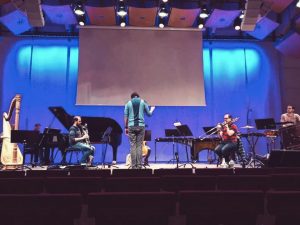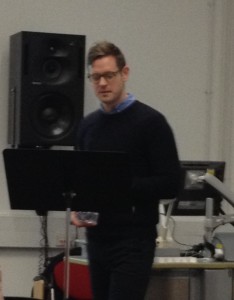Two members of the City Music department recently travelled to Sweden for world premieres of new works commissioned by the London based Riot Ensemble.
PhD student Georgia Rodgers and Senior Lecturer Dr. Aaron Einbond were selected to take part in the project during the Riot Ensemble’s 2017 Call for Scores, which received nearly 300 applications. An open workshop with the ensemble followed in September 2017, taking place at London’s Southbank as part of the Nordic Music Daysfestival. Six composers took part in total – Aaron, Georgia and Donghoon Shin based in the U.K, and Ansgar Beste, Marcella Lucatelli and Asta Hyvärinen from Sweden, Denmark and Finland.
Each composer then had around six months to complete their new piece before meeting in Helsingborg, Sweden, for a concert of premieres by the Riot Ensemble, given as part of the Swedish Society of Composer’s centenary celebrations (#FST100) on 14thApril.
The concert was really successful and Aaron and Georgia’s pieces were very well received. Georgia’s pieceMaeshoweis based on the resonant frequencies of an ancient site on Orkney. The instruments approximate these ‘room modes’ in various ways, and are overlaid with sine tones at the exact frequencies. Aaron’s piece Kate Frankensteinlooked into his family’s history, using video projection, live and pre-recorded sound to explore the story of one of Jack the Ripper’s victims.
It was fantastic to have the opportunity to work with the brilliant Riot Ensemble, who were: Ausiàs Garrigos (clarinet), Andy Connington (trombone), David Royo (percussion), Fontane Liang (harp), Neil Georgeson (piano), Louise McMonagle (cello) and Aaron Holloway-Nahum (director). We thank them very much and hope to collaborate with them again in future, and with our new Scandinavian friends!
—Georgia Rodgers





 On 9 March the research seminar welcomed Tom Perchard from
On 9 March the research seminar welcomed Tom Perchard from